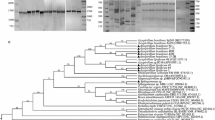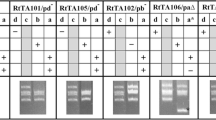Abstract
The plant growth-promoting proteobacterium Azospirillum brasilense enhances growth of many economically important crops, such as wheat, maize, and rice. The sequencing and annotation of the 1.59-Mbp replicon of A. brasilense CBG497, a strain isolated from a maize rhizosphere grown on an alkaline soil in the northeast of Mexico, revealed a GC content of 68.7 % and the presence of 1,430 potential protein-encoding genes, 1,147 of them classified into clusters of orthologous groups categories, and 16 tRNA genes representing 11 tRNA species. The presence of sixty-two genes representatives of the minimal gene set and chromid core genes suggests its importance in bacterial survival. The phaAB → G operon, reported as involved in the bacterial adaptation to alkaline pH in the presence of K+, was also found on this replicon and detected in several Azospirillum strains. Phylogenetic analysis suggests that it was laterally acquired. We were not able to show its inference on the adaptation to basic pH, giving a hint about the presence of an alternative system for adaptation to alkaline pH.






Similar content being viewed by others
References
Alexeyev MF (1999) The pKnock series of broad-host-range mobilizable suicide vectors for gene knockout and targeted DNA insertion into the chromosome of gram-negative bacteria. Biotechniques 26:824–828
Altschul SF, Madden TL, Schäffer AA, Zhang J, Zhang Z, Miller W, Lipman DJ (1997) Gapped BLAST and PSI-BLAST: a new generation of protein database search programs. Nucleic Acids Res 25:3389–3402
Baldani VLD, Baldani JI, Döbereiner J (1983) Effects of Azospirillum inoculation on root infection and nitrogen incorporation in wheat. Can J Microbiol 29:924–929
Bashan Y, Holguin G, de-Bashan LE (2004) Azospirillum-plant relationships: physiological, molecular, agricultural, and environmental advances (1997–2003). Can J Microbiol 50:521–577
Bi C, Benham CJ (2004) WebSIDD: server for predicting of the stress-induced duplex destabilized (SIDD) sites in superhelical DNA. Bioinformatics 20:1477–1479
Bocs S, Cruveiller S, Vallenet D, Nuel G, Médigue C (2003) AMIGene: annotation of MIcrobial genes. Nucleic Acids Res 31:3723–3726
Bozouklian H, Fogher C, Elmerich C (1986) Cloning and characterization of the glnA gene of Azospirillum brasilense Sp7. Ann Inst Pasteur Microbiol 137B:3–18
Caballero-Mellado J, López-Reyes L, Bustillos-Cristales R (1999) Presence of 16S rRNA genes in multiple replicons in Azospirillum brasilense. FEMS Microbiol Lett 178:283–288
Chilton MD, Currier T, Farrand S, Bendich A, Gordon M, Nester E (1974) Agrobacterium tumefaciens DNA and PS8 bacteriophague DNA not detected in crown gall tumors. Proc Natl Acad Sci USA 71:3672–3676
Creus CM, Graziano M, Casanovas EM, Pereyra MA, Simontacchi M, Puntarulo S, Barassi CA, Lamattina L (2005) Nitric oxide is involved in the Azospirillum brasilense-induced lateral root formation in tomato. Planta 221:297–303
Croes C, Van Bastelaere E, DeClercq E, Eyers M, Vanderleyden J, Michiels K (1991) Identification and mapping of loci involved in motility, adsorption to wheat roots, colony morphology, and growth in minimal medium on the Azospirillum brasilense Sp7 90-MDa plasmid. Plasmid 26:83–93
DelVecchio VG, Kapatral V, Redkar RJ, Patra G, Mujer C, Los T, Ivanova N, Anderson I, Bhattacharyya A, Lykidis A, Reznik G, Jablonski L, Larsen N, D’Souza M, Bernal A, Mazur M, Goltsman E, Selkov E, Elzer PH, Hagius S, O’Callaghan D, Letesson JJ, Haselkorn R, Kyrpides N, Overbeek R (2002) The genome sequence of the facultative intracellular pathogen Brucella melitensis. Proc Natl Acad Sci USA 99:443–448
Egan ES, Fogel MA, Waldor MK (2005) Divided genomes: negotiating the cell cycle in prokaryotes with multiple chromosomes. Mol Microbiol 56:1129–1138
Felsenstein J (1985) Confidence limits on phylogenies: an approach using the bootstrap. Evolution 39:783–791
García-Olivares J, Moreno-Medina V, Rodríguez-Luna I, Mendoza-Herrera A, Mayek-Pérez N (2007) Efecto de cepas de Azospirillum brasilense en el crecimiento y rendimiento de grano del maíz. Rev Fitotec Mex 30:305–310
Gil R, Silva FJ, Peretó J, Moya A (2004) Determination of the core of a minimal bacterial gene set. Microbiol Mol Biol Rev 68:518–537
Gonzalez V, Bustos P, Ramirez-Romero MA, Medrano-Soto A, Salgado H, Hernandez-Gonzalez I, Hernandez-Celis JC, Quintero V, Moreno-Hagelsieb G, Girard L, Rodríguez O, Flores M, Cevallos MA, Collado-Vides J, Romero D, Dávila G (2003) The mosaic structure of the symbiotic plasmid of Rhizobium etli CFN42 and its relation to other symbiotic genome compartments. Genome Biol 4:R36
Harrison PW, Lower RP, Kim NK, Young JP (2010) Introducing the bacterial ‘chromid’: not a chromosome, not a plasmid. Trends Microbiol 18(4):141–148
Hauwaerts D, Alexandre G, Das SK, Vanderleyden J, Zhulin IB (2002) A major chemotaxis gene cluster in Azospirillum brasilense and relationships between chemotaxis operons in α-proteobacteria. FEMS Microbiol Lett 208:61–67
Hynes MF, McGregor NF (1990) Two plasmids other than the nodulation plasmid are necessary for the formation of nitrogen-fixing nodules in Rhizobium leguminosarum. Mol Microbiol 4:567–574
Kadouri D, Jurkevitch E, Okon Y, Castro-Sowinski S (2005) Ecological and agricultural significance of bacterial polyhydroxyalkanoates. Crtical Rev Microbiol 31:55–67
Kaneko T, Minamisawa K, Isawa T, Nakatsukasa H, Mitsui H, Kawaharada Y, Nakamura Y, Watanabe A, Kawashima K, Ono A, Shimizu Y, Takahashi C, Minami C, Fujishiro T, Kohara M, Katoh M, Nakazaki N, Nakayama S, Yamada M, Tabata S, Sato S (2010) Complete genomic structure of the cultivated rice endophyte Azospirillum sp. B510. DNA Res 17:37–50
Lerner A, Okon Y, Burdman S (2009) The wzm gene located in the pRhico plasmid of Azospirillum brasilense Sp7 is involved in lipopolysaccharide synthesis. Microbiology 155:791–804
Martin-Didonet CCG, Chubatsu LS, Souza EM, Kleina M, Rego FGM, Rigo LU, Yates MG, Pedrosa FO (2000) Genome structure of the genus Azospirillum. J Bacteriol 182:4113–4116
Mavingui P, Flores M, Romero D, Martínez-Romero E, Palacios R (1997) Generation of Rhizobium strains with improved symbiotic properties by random DNA amplification (RDA). Nat Biotechnol 15:564–569
Mavingui P, Flores M, Guo X, Davila G, Perret X, Broughton WJ, Palacios R (2002) Dynamics of genome architecture in Rhizobium sp. strain NGR234. J Bacteriol 184:171–176
Michiels K, De Troch P, Onyeocha I, Van Gool A, Elmerich C, Vanderleyden J (1989) Plasmid localization and mapping of two Azospirillum brasilense loci that affect exopolysaccharide synthesis. Plasmid 21:142–146
Nelson LM, Knowles R (1978) Effect of oxygen and nitrate on nitrogen fixation and denitrification by Azospirillum brasilense grown in continuous culture. Can J Microbiol 24:1395–1403
Onyeocha I, Vieille C, Zimmer W, Baca BE, Flores M, Palacios R, Elmerich C (1990) Physical map and properties of a 90-MDa plasmid of Azospirillum brasilense Sp7. Plasmid 23:169–182
Paddan E, Bibi E, Ito M, Krulwich TA (2005) Alkaline pH homeostasis in bacteria: new insights. Biochim Biophys Acta 30:67–88
Pedrosa FO, Yates MG (1984) Regulation of nitrogen fixation (nif) genes of Azospirillum brasilense by nifA and ntr (gln) type gene products. FEMS Microbiol Lett 23:95–101
Pothier JF, Prigent-Combaret C, Haurat J, Moënne-Loccoz Y, Wisniewski-Dyé F (2008) Duplication of plasmid-borne nitrite reductase gene nirK in the wheat-associated plant growth-promoting rhizobacterium Azospirillum brasilense Sp245. Mol Plant Microbe Interact 21:831–842
Putnoky P, Kereszt A, Nakamura T, Endre G, Grosskopf E, Kiss P, Kondorosi A (1998) The pha gene cluster of Rhizobium meliloti involved in pH adaptation and symbiosis encodes a novel type of K+ efflux system. Mol Microbiol 28:1091–1101
Saitou N, Nei M (1987) The neighbor-joining method: a new method for reconstructing phylogenetic trees. Mol Biol Evol 4:406–425
Sambrook J, Fritsch EF, Maniatis T (1989) Molecular cloning: a laboratory manual, 2nd edn. Cold Spring Harbor Laboratory, Cold Spring Harbor
Sant’Anna FH, Almeida LGP, Cecagno R, Reolon LA, Siqueira FM, Machado MRS, Vasconcelos ATR, Schrank IS (2011) Genomic insights into the versatility of the plant growth-promoting bacterium Azospirillum amazonense. BMC Genomics 12:409–422
Simon R, Priefer U, Pülher A (1983) A broad host range mobilization system for in vivo genetic engineering transposon mutagenesis in gramnegative bacteria. Bio/Technology 1:784–791
Tamura K, Peterson D, Peterson N, Stecher G, Nei M, Kumar S (2011) MEGA5: molecular evolutionary genetics analysis using maximum likelihood, evolutionary distance, and maximum parsimony methods. Mol Biol Evol 28:2731–2739
Tarrand JJ, Krieg NR, Döbereiner J (1978) A taxonomic study of the Spirillum lipoferum group, with descriptions of a new genus, Azospirillum gen. nov. and two species, Azospirillum lipoferum (Beijerinck) comb. nov. and Azospirillum brasilense sp. nov. Can J Microbiol 24:967–980
Thompson JD, Higgins DG, Gibson TJ (1994) CLUSTAL W: improving the sensitivity of progressive multiple sequence alignment through sequence weighting, position-specific gap penalties and weight matrix choice. Nucleic Acids Res 22:4673–4680
Vallenet D, Labarre L, Rouy Z, Barbe V, Bocs S, Cruveiller S, Lajus A, Pascal G, Scarpelli C, Médigue C (2006) MaGe: a microbial genome annotation system supported by synteny results. Nucleic Acids Res 34:53–65
Van Dommelen A, Van Bastelaere E, Keijers V, Vanderleyden J (1997) Genetics of Azospirillum brasilense with respect to ammonium transport, sugar uptake and chemotaxis. Plant Soil 194:155–160
Vanbleu E, Marchal K, Lambrecht M, Mathys J, Vanderleyden J (2004) Annotation of the pRhico plasmid of Azospirillum brasilense reveals its role in determining the outer surface composition. FEMS Microbiol Lett 232:165–172
Vernikos GS, Parkhill J (2006) Interpolated variable order motifs for identification of horizontally acquired DNA: revisiting the Salmonella pathogenicity islands. Bioinformatics 22:2196–2203
Vial L, Lavire C, Mavingui P, Blaha D, Haurat J, Möenne-Loccoz Y, Bally R, Wisniewsky-Dyé F (2006) Phase variation and genome architecture changes in Azospirillum. J Bacteriol 188:5364–5373
Waack S, Keller O, Asper R, Brodag T, Damm C, Fricke WF, Surovcik K, Meinicke P, Merkl R (2006) Score-based prediction of genomic islands in prokaryotic genomes using hidden Markov models. BMC Bioinform 7:142
Wisniewski-Dyé F, Borziak K, Khalsa-Moyers G, Alexandre G, Sukharnikov LO, Wuichet K, Hurst GB, Hayes-McDonald W, Robertson JS, Barbe V, Calteau A, Rouy Z, Mangenot S, Prigent-Combaret C, Normand P, Boyer M, Siguier P, Dessaux Y, Elmerich C, Condemine G, Krishnen G, Kennedy I, Paterson AH, González V, Mavingui P, Zhulin I (2011) Azospirillum genomes reveal transition of bacteria from aquatic to terrestrial environments. PLoS Genet 7:e1002430
Yamaguchi T, Tsutsumi F, Putnoky P, Fukuhara M, Nakamura T (2009) pH-dependent regulation of the multi-subunit cation/proton antiporter Pha1 system from Sinorhizobium meliloti. Microbiology 155:2750–2756
Acknowledgments
Erika Acosta-Cruz acknowledges support from CONACyT and SIP-IPN through Ph.D. fellowships. We also thank Alberto Mendoza and the CBG IPN for providing bacterial strains and facilities. This work was partially funded by projects 48044 from CONACyT to MV and the Centre National de la Recherche Scientifique to PM.
Author information
Authors and Affiliations
Corresponding author
Additional information
Communicated by Erko Stackebrandt.
Electronic supplementary material
Below is the link to the electronic supplementary material.
Rights and permissions
About this article
Cite this article
Acosta-Cruz, E., Wisniewski-Dyé, F., Rouy, Z. et al. Insights into the 1.59-Mbp largest plasmid of Azospirillum brasilense CBG497. Arch Microbiol 194, 725–736 (2012). https://doi.org/10.1007/s00203-012-0805-2
Received:
Revised:
Accepted:
Published:
Issue Date:
DOI: https://doi.org/10.1007/s00203-012-0805-2




